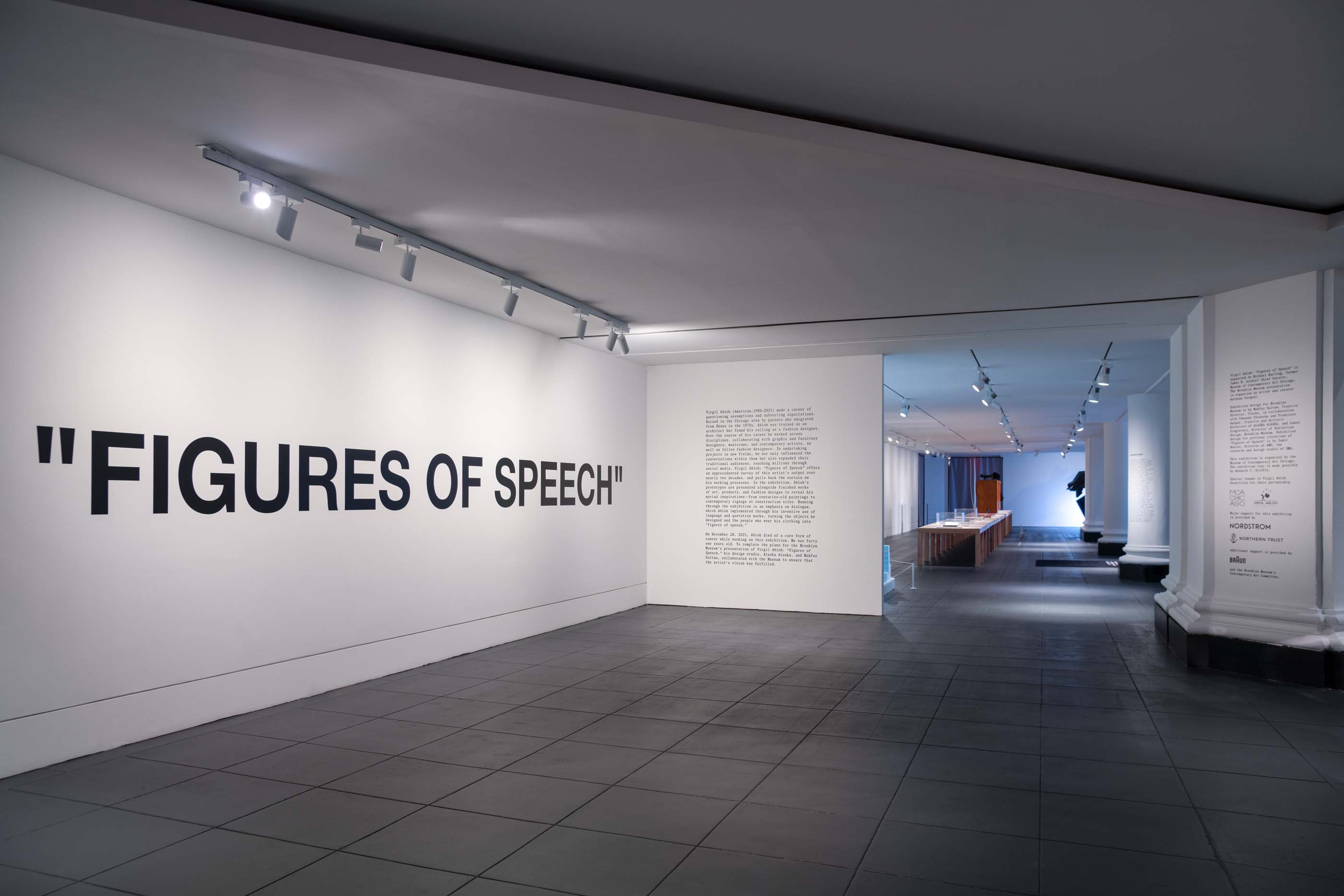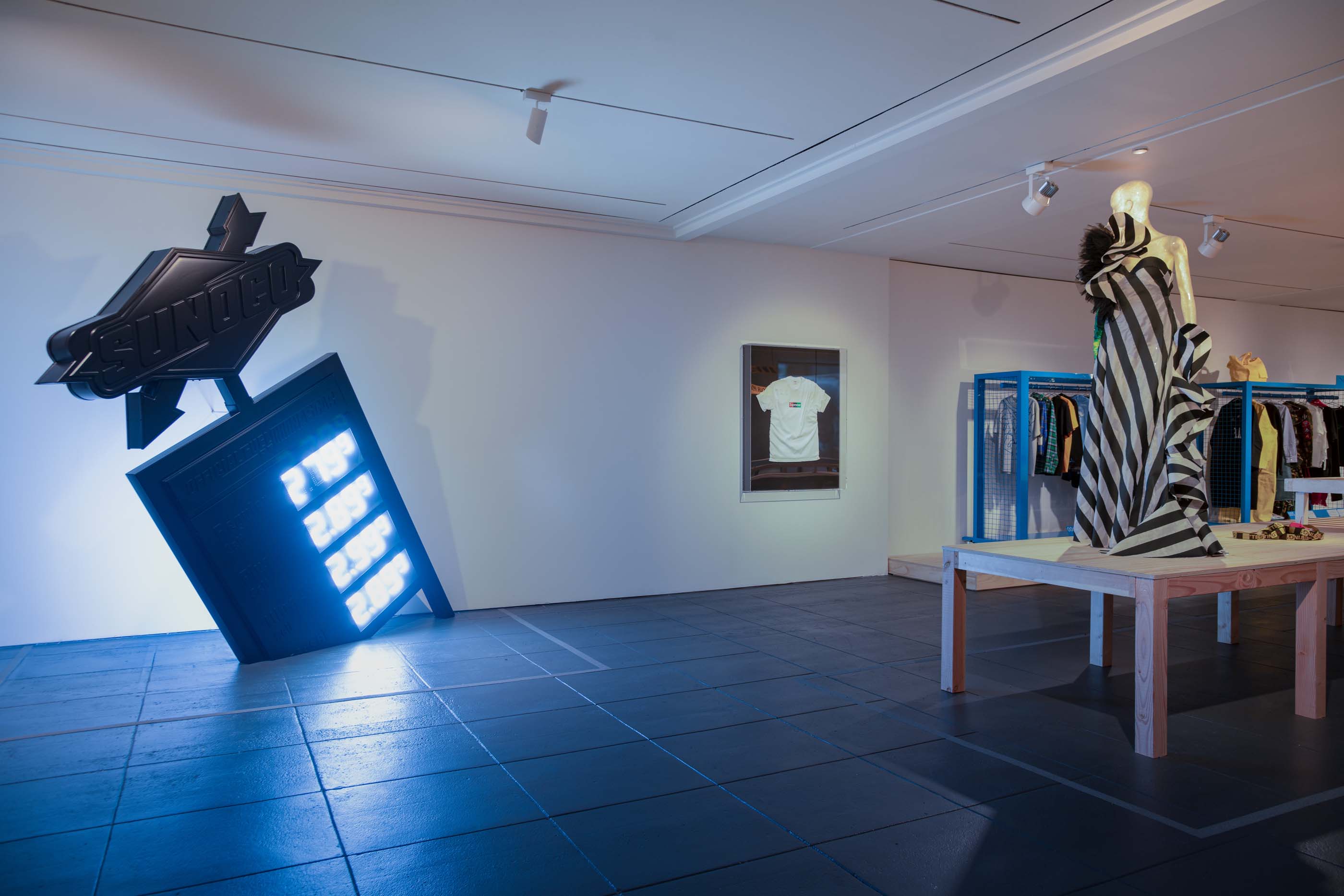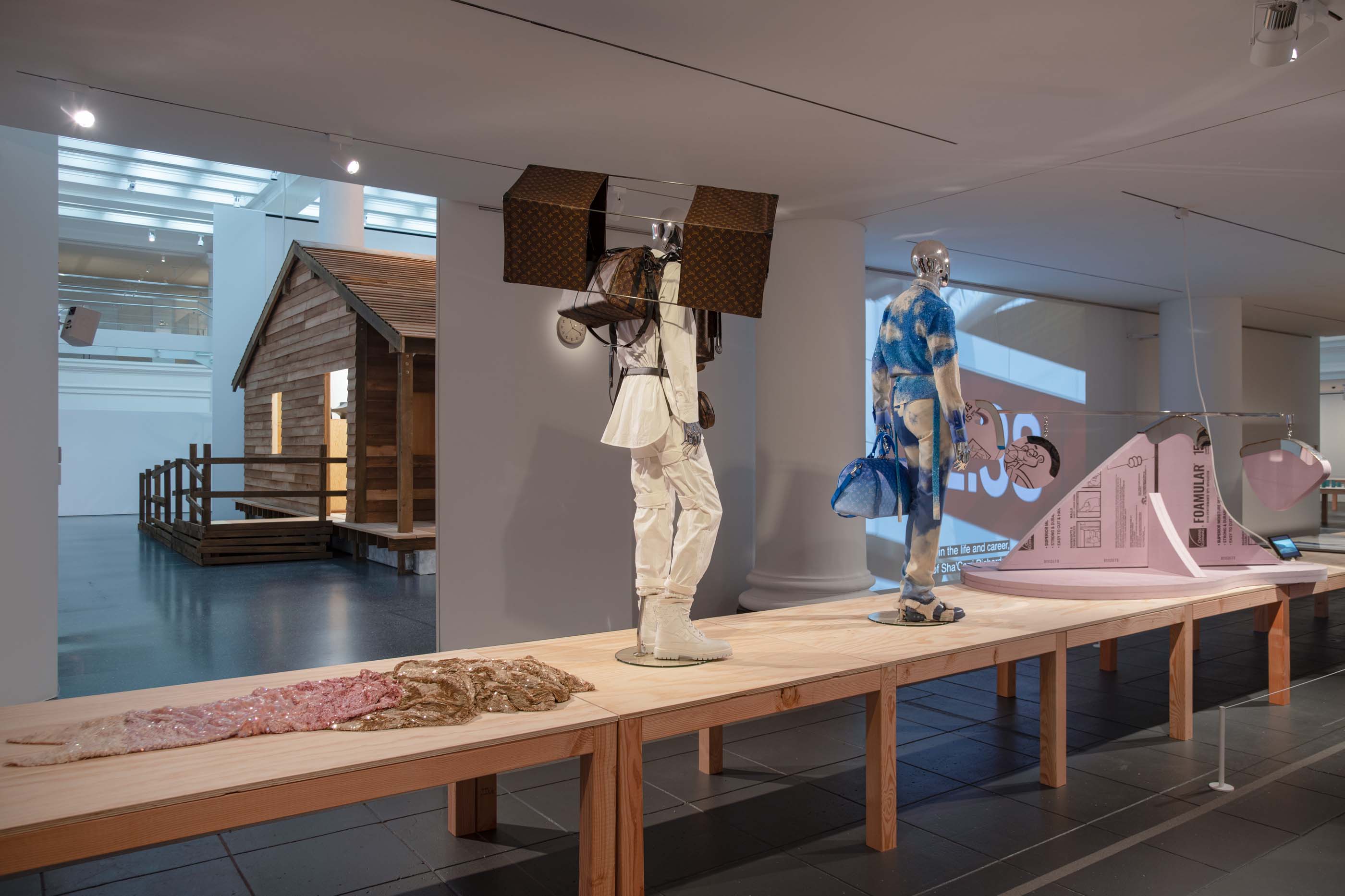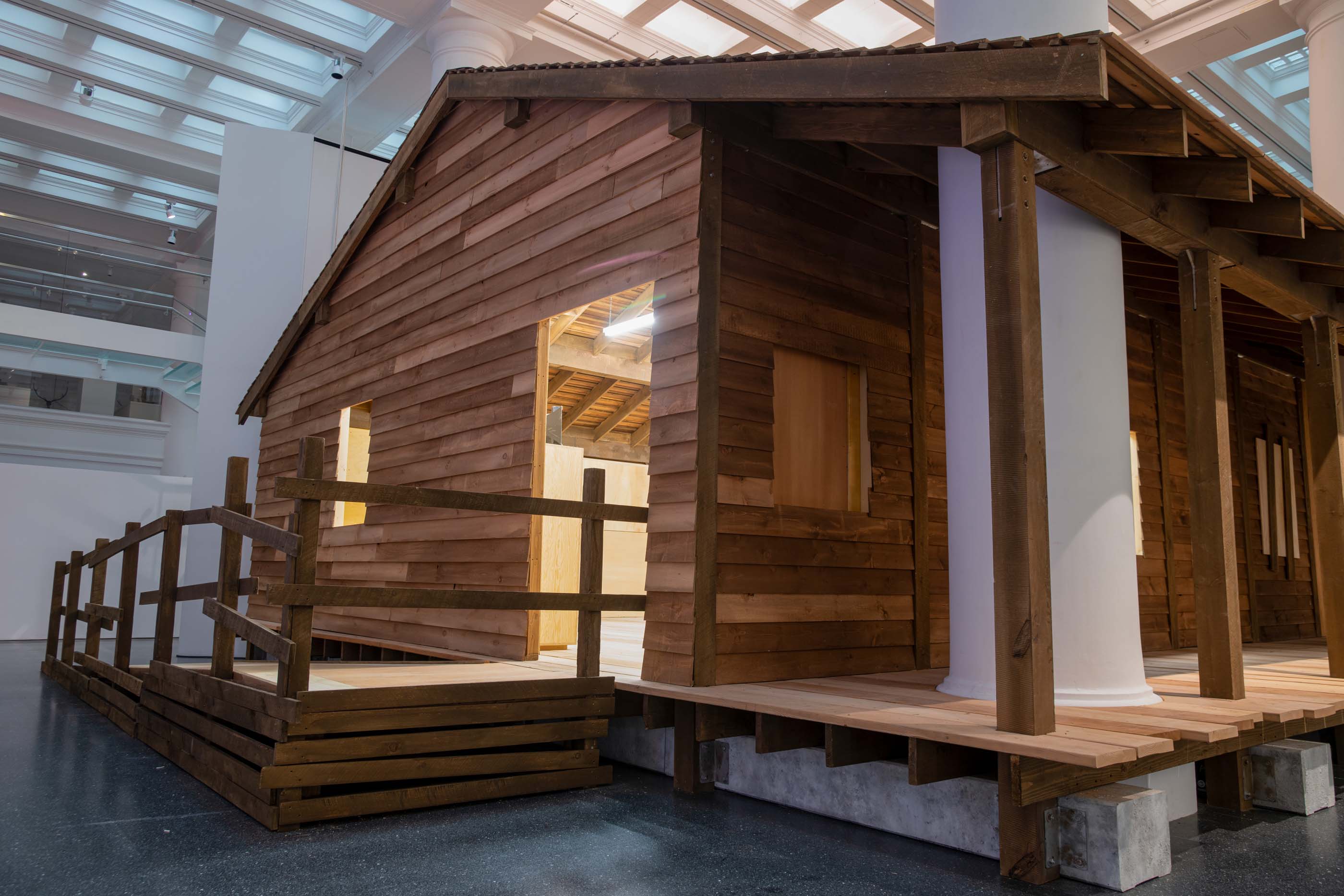Brooklyn Museum stages retrospective exhibition on “total artist” Virgil Abloh
Virgil Abloh: “Figures of Speech”
Brooklyn Museum
200 Eastern Parkway
Brooklyn, New York 11238
Open through January 29, 2023
On the first day of his master’s degree in the architecture program at the Illinois Institute of Technology, Virgil Abloh, born about an hour away to Ghanian immigrants, gazed in awe at the column-free voids of the school’s Mies van der Rohe campus. Then he looked at his textbook.
“I think I misread what architecture was all about,” he told the fashion editor Anja Aronowsky Cronberg many years later during a conversation for the London College of Fashion. He had come up in suburban worlds of skateboarding and punk and hip-hop and streetwear, made a home for himself in the small mixed use community center that fostered them all. He had studied engineering in college to make his dad happy: It would lead to a secure job with which to secure the American dream. But a college art class encounter with Caravaggio changed all that. “It helped me see art as something that wasn’t just for rich people. [It] made me look at my own life differently, and it spurred me into architecture. It was the only creative thing I could do without wasting the five years I’d spent in engineering.”
In his master’s textbook, Abloh saw the word gesamtkunstwerk. “I thought, oh sweet,” he told Cronberg, “I’ve found the one profession within art that touches on every discipline…that you could be completely interdisciplinary, a total artist. Well, turns out architecture isn’t exactly like that. But then again, I guess I found a way to get closer to the idea of total art after all.”

This origin story comes courtesy of the catalog accompanying Virgil Abloh: Figures of Speech, the first museum retrospective of the architect, product and fashion designer, and DJ who collaborated with everyone from Kanye to IKEA. Curated by Michael Darling, the show opened at the Museum of Contemporary Art Chicago in 2019. At the time of his death in November 2021 at age 41 due to a rare form of cancer, Abloh had already begun remixing the show with curator and writer Antwaun Sargent for the Brooklyn Museum. That iteration, completed by Abloh’s design studio Alaska Alaska and designer Mahfuz Sultan, opened July 1.
Figures argues for Abloh as, if not the total artist, the total package. His various outputs—early apparel for his Pyrex line, emblazoned with his logo and Michael Jordan’s jersey number; a queue of marked-up Nike prototypes; bespoke DJ setups playing mashups of the Pretty Woman shop clerk sneering “You’re obviously in the wrong place” taken from OFF-WHITE’s Fall/Winter 2016 runway show; metal-grid furniture powdercoated in rainbow gradients—move beat by beat down austere wood tables, also of Abloh’s devising.

More grids, this time in electric blue, stock selections from his epochal 2018–21 tenure as artistic and then creative director of menswear at Louis Vuitton, which not only proved the shamefully undertested notion that a Black man can head a global fashion house, but also that sweatsuits can be as crisply luxurious as any old LV pret-a-porter.
To be clear, Abloh was no Caravaggio. His talent was conceptual, like Duchamp, who Abloh famously called “his lawyer” in defense of appropriation. Abloh’s most potent tool wasn’t CAD, or Traktor, or Illustrator, or scissors. It was a pair of quotation marks, which he deployed across apparel and the internet like Warhol’s silkscreen or Dilla’s MPC to slice and dice, swipe and spotlight. In printing the word (or maybe it’s a phrase) “SCARF” in Helvetica, that European Voice of Authority font, across a black scarf, as he did for his OFF-WHITE “Glass House” Pre-fall 2018 collection, Abloh frames reality in a few quick lines. It’s a mastermix of This-Is-Not-A-Pipe tomfoolery, adolescent says you insouciance, and logo logorrhea embedded in the act of attribution itself. It empties a label of its meaning. It’s a terminal gesture that makes way for new life.

Perhaps, however, given the stratospheric price-points and intentional scarcity, little of Abloh’s work is necessarily “art as something that wasn’t just for rich people.” To get to the heart of Figures of Speech, one must first pass a gift shop kept behind the paywall of admission. It’s a nook for exclusive, expensive children’s fleecewear, keychains, notebooks, and handbags. Those gradient chairs are for sale, price upon request. (If you have to ask, are you in the right place?) On a nearby structural column, text characterizes Abloh as “recognizing that capitalism and consumption are inevitably present in the invention and creation of objects.” Recognizing, not believing. It’s one thing for a fashion designer to assert there’s no creation without capitalism; it’s something very different for the Brooklyn Museum to vouch for such a claim’s veracity.
Institutional cynicism notwithstanding, Figures of Speech offers evidence that American dreams are no longer built, if they ever were; they’re bought into. Abloh’s roots in and contributions to Black culture and his embodiment of today’s ne-plus-ultra identity–that of the creative director–define his contemporary desirability. The show will be a blockbuster, and that shop may just sell out.

Past all that is the heart of the exhibition, Abloh’s final work. It’s not, sadly, proof of completion of the hometown skyscraper, bending gracefully over Lake Michigan, shown in a model of his Master’s thesis at the start of the show. Instead, it’s a full-size home, so big it embraces several of the kind of structural columns van der Rohe attempted to eliminate and so welcoming that it offers a full gabled porch and, inside, what’s sure to be a killer soundsystem, designed by Devon Turnbull. The structure, called Social Sculpture, is a kind of community canvas. Brooklyn Museum has a slate of programming for it, including talks from Abloh cohort members like Hood by Air’s Shayne Oliver; a pass to four of the talks costs about the same as a show-branded hoodie. It’s a readymade set for social media. But maybe visitors can appropriate it for more provocative ends. It could be a pull-quote of the subcultures where Abloh found his footing, a fashion house anyone can climb into, a library of people to check and check out. Like Abloh studying within van der Rohe, maybe it can be a space for those who come next to find out what’s here for them.
Jesse Dorris is a writer in New York City and hosts Polyglot, a radio show on WFMU.


